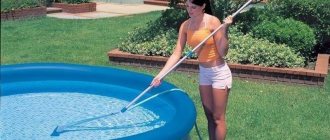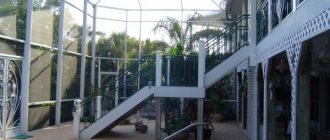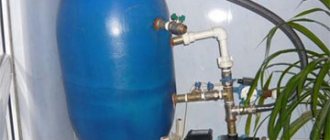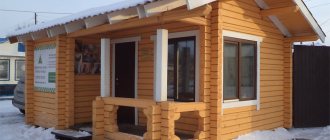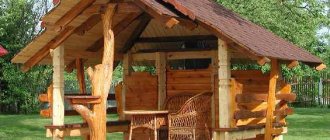A couple of decades ago, a swimming pool at a dacha was considered a curiosity and was evidence of the financial well-being of the owners of the site. The development of modern technologies helps to simplify the process of arranging an artificial reservoir in the open air. Designing a pool includes many stages, from choosing a shape to landscape design of the surrounding area. Familiarization with the nuances of design will help you competently approach the issue of arranging your own pool at the dacha.
Suburban area: a heavy burden or a place of rest
The mentality of the Soviet people, for whom the main purpose of the dacha was to grow vegetables and fruits, is gradually becoming a thing of the past. Nowadays they pay more attention to the landscape design of their summer cottage and take care of a comfortable pastime. A traditional bathhouse and a well-groomed lawn, a continuously blooming mixed border and an artificial pond are a classic set for complete relaxation.
A swimming pool at the dacha is not only an opportunity for children and adults to have fun, but also an excellent opportunity to improve the health of the body through moderate physical activity. The presence of large quantities of water on the site creates pleasant coolness on a hot day and improves the microclimate. Another advantage of having a swimming pool at your dacha is the presence of a reserve water tank, which can be used for irrigation in case of interruptions in the central water supply.
Depending on the size, you can organize the design of a swimming pool at your dacha yourself or seek the help of specialists.
Comment! A three-dimensional design will definitely require consultation from engineers and the supply of communications, otherwise amateur efforts will lead to disastrous results during operation.
Numerous innovative developments make it possible to select the optimal pool option for a dacha, depending on the age category of the main users, the size of the dacha plot and the financial capabilities of the owners.
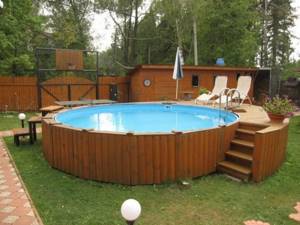
How to make a pool from scrap materials with your own hands
Any owner of a summer cottage can make a frame pool with his own hands from scrap materials. Such structures do not require any special skills. It is important to follow the instructions and choose the right material.
Gabion pool
A gabion is constructed from metal mesh and stones. This design prevents the soil from subsiding and prevents its erosion. Stone sides will hold water well. But it is additionally recommended to do waterproofing.
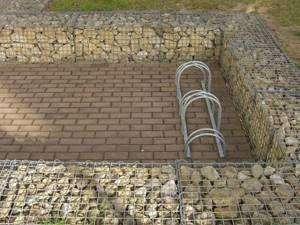
It is important to place a flat sheet of material inside the future reservoir, covering it with film
Gabions can be replaced with a self-welded mesh of any shape filled with stones. Pools made of this material allow you to avoid spending money on finishing external walls, which is an economical option when building a swimming area.
Advice! It is recommended to build a side at the top so that it is safe to walk on it barefoot.
Swimming pool from a shipping container
If you have an old car container at your dacha, it can be used to create an artificial pond.
Pros of this pool:
- easy to build without additional costs and labor;
- affordable price;
- thanks to the metal frame, the design will be durable;
- There is no additional need to dig a pit; it is enough to weld the stairs to the top;
- if desired, you can deepen the container halfway into the ground;
- the necessary communications are easily installed;
- easy to dismantle and move to any place.
The inside of such a pool can be finished with porcelain stoneware. By attaching wooden formwork with steps, you can get a small changing room.

An artificial pond made from a container looks gorgeous and will last a long time
Nuances when constructing a swimming area from a transport container:
- if the container is old, it is worth checking for damage; if there is any, it is necessary to repair it;
- it is necessary to clean off the rust, cover the container with a primer and mastic;
- After all manipulations, the container is covered with waterproofing.
Important! A container pool for children will be large. For them, it is recommended to take a container from a small car.
A small artificial pond made of tires
You can make a do-it-yourself children's pool from scrap materials from vehicle tires.
Technique for creating a pool from a tire:
- The first step is to choose the largest tire.
- Having chosen a place for the future “paddling pool”, place a tire on it. The bottom is sealed with concrete mortar and left to harden for several days.
- After the concrete has completely hardened, the wheel is filled with water to check for leaks.

- Use a sharp knife to cut off the sidewall of the tire.
- The walls of an artificial pond can be painted with bright colors to make it attractive.
- The pool made from a tire will appeal to children of any age. They will be able to improve their health and harden themselves in fresh water on a hot summer day.
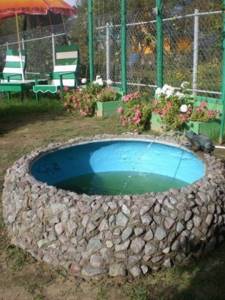
Externally, the tire can be decorated with stonework
Country version of an artificial pond made from beer crates
You can build an interesting version of a swimming pool from empty beer crates. The body of the future reservoir is laid out using boxes, which are connected from the outside to each other using nylon cables. To prevent water from leaking, a PVC film is lined inside, which is securely attached to the boxes. After filling the container, it is important to check for leaks.
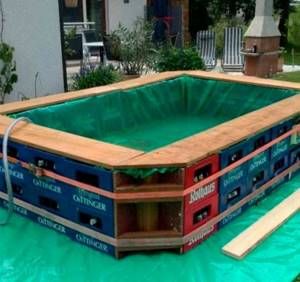
A pond made from beer crates looks interesting; it is recommended to make wooden sides on top for a comfortable rest
Concrete pool
A concrete pool is a high-quality, long-lasting building that you can build yourself in your dacha. Concrete and sand are bonded together and sprayed onto the metal frame.

Thanks to step-by-step actions, building a concrete pond at your dacha will be easy and quick
Technique for constructing a “jacuzzi” from concrete:
- Dig a hole for an artificial pond. Its dimensions should be 25 cm larger than the estimated size of the pool.
- Install water supply and all necessary pipes for safe water flow. They use PVC structures and strong binding material.
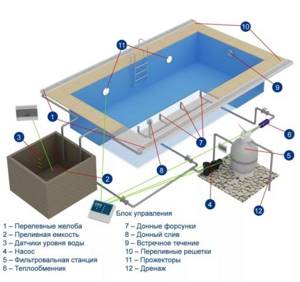
- The walls and bottom are covered with a steel frame to maintain its shape and strength throughout the entire period of its use.
- Using a powerful sprayer, the steel mesh is covered with a concrete-sand mixture. It is important to keep the nozzle at a distance of 1 meter from the mesh. The jet is directed perpendicular to the surface and moved in a circular motion.
- After the concrete has hardened, you can make the walls of the pool by finishing them with tiles or paint.
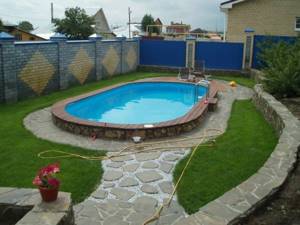
A concrete pool will bring a lot of pleasure to vacationers in the country
Container made of wooden panels
To make a wooden pool, you need to take bars measuring 60x60 mm and smooth planks from 30 mm. The artificial pond will have the shape of an octagon.
Step-by-step construction instructions:
- First, eight shields as high as the depth of the bowl are knocked down.
- The container can simply be placed on the surface or slightly deeper into the soil. If the choice falls on a recess, a small pit is dug, reinforcement is laid and concrete is poured. If you decide not to deepen the bowl, knock the thick boards together tightly enough.
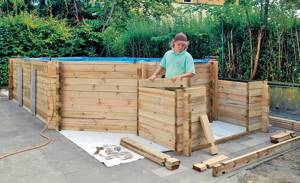
- Having assembled the shields into one structure, make the necessary holes. Then the bowl is covered with PVC film for waterproofing.
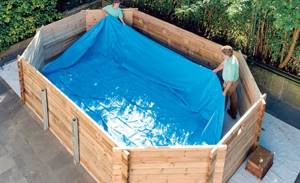
- The pool is filled with water, checking for leaks.
- It is also necessary to install a wooden ladder and the upper edges of the sides.
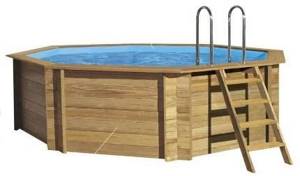
It is recommended to equip a wooden artificial pond with handrails for ease of use
Attention! All wood must be treated with an antiseptic so that the pool does not have to be rebuilt several times throughout the swimming season.
Polypropylene and fiberglass pool in the country
A swimming pool at the dacha made of polypropylene and fiberglass is equipped as follows:
- The bottom of the pit is filled with a concrete slab.
- Install the purchased bowl.

- Installation of communications is carried out, a layer of fiberglass rods is laid.

- Spacers are installed inside the container and partially filled with water.
- The space between the sides of the bowl and the wall is filled with mortar.
- As soon as the concrete hardens, the edges of the pool and the surrounding area are refined.
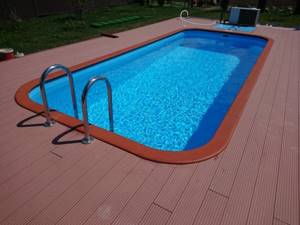
A polypropylene pool can be equipped using sheets with a thickness of 10 mm or more. The bowl can be created in any size and shape. It is important to correctly weld the sheets to each other.
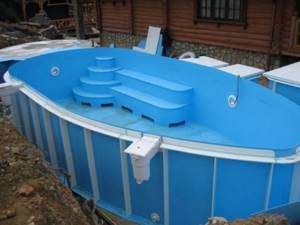
A small bowl does not need to be filled with concrete; it is enough to cover it outside with crushed stone or compact it with soil
Warning! It is important to insulate the pipes in the ground, the walls and the bottom of the pool with special means before pouring concrete. If suddenly there is a poor-quality drainage of water from the system before conservation, the pool will not be damaged.
Types of outdoor pools
The process of designing an artificial reservoir begins with choosing a suitable design. Outdoor swimming pools fall into three main categories:
- stationary;
- collapsible;
- inflatable.
They all vary in shape, size, complexity of design and care. Each option has undeniable advantages and some negative points.
Stationary
The design of stationary models is appropriate for a spacious dacha; their arrangement is a one-time project and is characterized by significant material investments. Typically, this method of registration is used when visiting a dacha frequently or living permanently. Stationary pools have medium or large dimensions. They are designed in various ways:
- by installing a frame on the soil surface;
- by digging a pit.
Subsequent internal arrangement of the pit is carried out using cladding or by installing a finished bowl. Multi-level structures look very impressive.
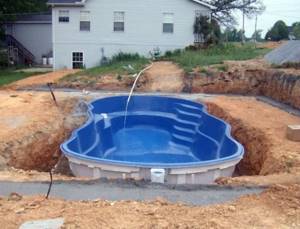
Attention! Designing a permanent swimming pool at your dacha requires the presence of additional communication systems. The required minimum is to organize a water supply, provide a cleaning system and further drainage of liquid. Neglecting the conditions will lead to rapid stagnation of water, its blooming and other problems.
The decision to design a swimming pool with a roof or canopy is practical. Such protection will reduce the clogging of water with debris and dust, especially if long breaks in use are planned.
When choosing material for a stationary model for your dacha, take into account the climate. Even in the absence of liquid, not all containers are able to maintain their integrity under the influence of severe frosts. Therefore, a thorough study of the characteristics of the material for a pool at the dacha is an integral condition for its further long-term operation.
Demonstrates the harmonious design of the pool at the dacha photo:
Collapsible
Setting up a collapsible swimming pool at your dacha is accompanied by lower material and labor costs. They usually offer models in small and medium sizes. Oversized structures are impractical due to the complexity of installation and dismantling.
A collapsible frame pool is ideal for an unguarded summer house. At the beginning of the season, it is collected and filled with water, and when constant coolness sets in, the liquid is disposed of, dismantled and stored in the utility room.
The design of a collapsible frame pool at the dacha is also not complete without installing treatment systems, but in terms of complexity they are much simpler than for stationary tanks. Typically, a treatment system requires medium-sized containers. If you set up a small artificial pond at your dacha, you can get by with periodically changing the water and using various reagents for disinfection.
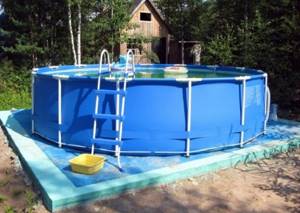
Inflatable
It’s easy enough to organize swimming at your dacha using an inflatable pool model. They are usually purchased for children's entertainment. There are many advantages to designing an inflatable tank:
- affordable price for the common man;
- quick installation and ease of assembly;
- does not require large free space;
- there is no need to install communications and purchase treatment systems;
- mobility and compactness.
Inflatable pools are represented not only by compact models. For your dacha, you can purchase a medium-sized tank, where older age groups have the opportunity to splash around. Typically, such products are supplemented with a frame made of aluminum tubes for stability.
Advice! If the height of the pool is above one meter, it is worth taking care of the design of the structure with a ladder. This will make the entry/exit process easier and prevent the sides from sagging. Otherwise, the integrity of the inflatable product may be compromised and the problem of water overflow may arise.
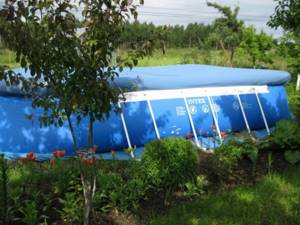
Manufacturing materials
Decorating a swimming pool at your dacha is a multifaceted task. After determining the type of design, it is important to study the characteristics of the material from which the tank is made. Manufacturers usually offer three design options:
- polypropylene;
- plastic;
- composite material.
Tanks made of polypropylene have high technical characteristics. Excellent tolerance to low temperatures will allow you to design stationary pools with similar containers.
When decorating an artificial pond at a dacha, plastic is less practical. In the cold, the material becomes brittle and there is a risk of its destruction, so it is not suitable for large containers. Plastic decoration is more often used for folding structures and when installing decorative pools.
Decorating a dacha with models made of composite material is the most practical solution with the following advantages:
- The ability to take on any shape allows you to design a pool of various sizes and configurations.
- The walls of the container are made of composite material and are not subject to deformation and cannot be scratched.
- The strength of the material ensures long-term operation of the pool in the country.
Which option to choose depends on the planned costs, intensity and duration of operation.
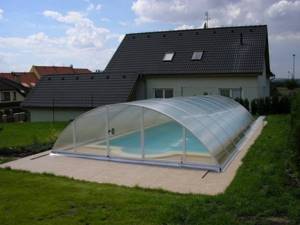
Disadvantages of a swimming pool at the dacha
What difficulties will everyone face who decides to build a swimming pool on their summer cottage?
Small plot area
Availability of free space. On a standard summer cottage plot of 6 acres, you must place a house, outbuildings, a garden and a vegetable garden. Do you also have enough space for a swimming pool?
Pool storage
Pools come in different types: inflatable, frame, stationary, etc.
- What type of pool should I install in my dacha?
Have you decided that your suburban area doesn’t have enough swimming pool? It's time to correct this omission.
An inflatable pool, for example, has two main disadvantages:
- It can be damaged by any sharp object. It could be a stone, broken glass, or the claws of your favorite pets.
- To store it indoors you need to allocate a lot of space. Unfortunately, it will no longer be possible to fold the pool the way it was folded when purchased. You cannot leave it outside: low temperatures will damage the material from which the pool is made. For the same reason, you cannot store your pool in unheated rooms in winter. In addition, there should be no rodents or clawed pets in the “wintering” area of your pond.
Pool arrangement
If you decide to choose a more reliable design - a stationary pool, then be prepared for other difficulties. Arranging such a reservoir is not an easy task. It's unlikely that you can handle this on your own. But even if you hire specialists, this will not relieve you of worries. First, you will have to dig a pit. And this is titanic work, which also costs a lot of money. Secondly, you will have to deal with the issue of excavated soil. It will either need to be moved to the other end of the site, or taken out altogether.
High water consumption
The amount of water needed to fill depends on the pool you choose. For example, with a length of 4 m and a width of 2.5 m, to fill a two-meter deep pool you will need 20 cubic meters of water. And so much water will need to be poured into it more than once during the season. It turns out that this pleasure is not cheap. Are you willing to pay for it?
Where to drain the water from the pool?
However, the difficulties do not end there. Time passes, and you need to pour this water out of the pool. The question arises: where to put this mass of water? It’s good if you have a plot with a slope and free territory below. Then the water will just flow there. But what if the plot is flat or the neighbors’ land is below? One way to solve the problem is to pour out the water in parts so that it is slowly absorbed into the soil. However, in this case it will take you a lot of time.
Pool maintenance
So, the pool is installed, the water is filled. And now one of the biggest difficulties for owners of their own pond arises - pool maintenance. If you pour water and forget about it, after some time you will find, instead of a pool with soft blue water, a pond with frogs and a specific smell. You will be punished for your indifference.
- Why does the water in an outdoor pool turn green and how to prevent it?
Pool owners often face such a serious problem as water algae. What to do? How to restore transparency and blueness to water?
The most important thing in pool care is the destruction of bacteria and algae that cause water blooms. To do this, you will need a filter with a powerful pump and regular treatment of water with chlorinating agents and algaecides. All this is additional cash investment.
If you decide to neglect this point and do not take care of it in time, then you will have to take radical measures - completely drain the water, clean and refill the reservoir.
Protecting your pool from debris
The flowering process is accelerated by debris flying from everywhere. These include leaves, branches, grass, and various insects. This means that the pool needs to be protected from such dirt. An awning or cover will help with this. The inconvenience is that you will have to constantly cover the pool or remove the protection. If you do not do this, you will have to remove the debris with a net or your hands. Although, of course, compared to previous problems, these are just flowers.
Low water temperature
In the conditions of the middle zone with its low night temperatures, it is quite difficult to warm up even a one and a half meter layer of water. For this reason, most likely you will have to carry out water procedures in water that is not entirely comfortable.
Short period of use
A swimming pool is a pleasure only for the summer months. And if you also subtract all the rainy and/or cold days from the three months of summer, it turns out that you can only use the bathhouse for a month or two a year. The rest of the time it will stand idle. But you will have to maintain the pool in any weather. So is the game worth the candle?
Filling level
The water level in a stationary pool depends on the type of structure, which can be:
- overflow;
- skimmer system.
In the first case, it is planned to design a grate around the perimeter of the tank, through which the splashed liquid is sent to the storage tank. Filling the bowl to the brim visually increases the size of the pool at the dacha.
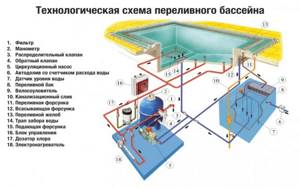
With a skimmer system, filling the container requires the presence of a minimum reserve within 15 cm from the top edge of the side. The absence of storage tanks does not allow water to be thoughtlessly splashed; it will not return back to the pool.
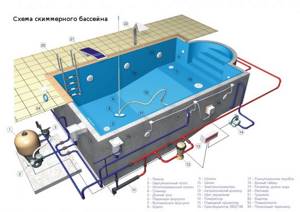
Baths, saunas and swimming pools
-21 vote
+
Vote for!
—
Vote against!
Even the smallest and outwardly unremarkable garden plot can be made cozy and interesting if you equip it with an artificial pond. A decorative pond in the garden can not only harmoniously fit into the landscape of a personal plot, but also visually expand the space.
- Artificial pond in the landscape of a personal plot
- Do-it-yourself decorative pond - where to start?
- Construction of a decorative pond
- How to make a decorative pond so that the water in it is always clean and fresh?
- Construction of a decorative pond using galoshes
- Decoration of the banks of an artificial reservoir
- Pond care
Artificial pond in the landscape of a personal plot

The presence of a pond or a small artificial waterfall on a personal plot is determined not only by aesthetic considerations, but also by a practical component. On a hot summer day, even a small body of water feels cool, the air seems much cleaner and fresher, and the calm surface or the measured murmur will help relieve nervous tension and fatigue.
The most popular types of artificial reservoirs in landscape design:
- pond;
- Creek;
- fountain;
- waterfall.
The shape of reservoirs on personal plots can be either round, with an irregular coastline, or regular geometric shape - square, rectangular and diamond-shaped. It all depends on the style of the site as a whole, its location, the characteristics of the site and your imagination. The main rule here is that the reservoir must ideally fit into the surrounding landscape and become its integral element.
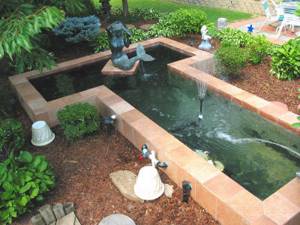
The most common shape for an artificial pond is round or oval. This is exactly what natural lakes look like, so if you want to create a corner of nature near your house or in the garden, then this option will be the most acceptable. In this case, there may even be an irregular coastline and asymmetric planting of the reservoir with plants.
If the pond is located on an area where everything is done in a classical style, straight lines dominate and there is no room for natural forms, then a pond of the correct shape is arranged. Often, this is the basis for a fountain, which is the center of the exhibition. Since such a pool does not have a natural barrier in the form of vegetation and stones, its sides must be placed higher to prevent it from falling into the water. An alternative is to fence such a pond with a low forged lattice.
It should be noted that the most common and least expensive in terms of labor and financial investments is a pond. But it is quite possible to arrange one on your site yourself without involving specialists.
The main thing here is experience. When it appears, the pond you create may become the first in the whole complex, connected by waterfalls, streams, and decorative bridges.
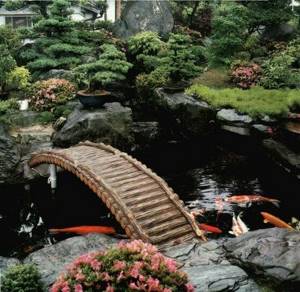
Do-it-yourself decorative pond - where to start?
If a wonderful idea has occurred to you about arranging an artificial pond on your garden plot, you should not rush headlong to get a shovel. First of all, you need to choose a good place. The following factors must be taken into account:
- plot size;
- illumination;
- relief;
- degree of landscaping;
- soil type.

It is best to equip a pond closer to your home. In this case, it should be positioned in such a way that the entire area of the reservoir is illuminated by the sun for at least 5 hours a day. Otherwise, over time, a once beautiful pond may simply turn into a stinking swamp.
The terrain is also of great importance. The optimal location is a low-lying area where the water level in a well or well is closer to the surface of the earth.
During the selection process, you should also pay attention to the presence of vegetation - large trees located along the banks will pollute the pond with fallen leaves in the autumn, and tree roots can damage the protective film on the bottom.
The type of soil is important. Loamy and clayey soils, as well as peat soils, are suitable for arranging a reservoir; chernozem is less preferable - it promotes the formation of silt. On acidic soils, it is impractical to equip a reservoir without reliable protection of the side walls and bottom.
After the site has been selected, the shapes and sizes have been determined - it’s time to stock up on the necessary materials and tools. Most often, to create a pond, they use ready-made rigid containers, which can be purchased at a specialized store, or flexible waterproofing, much less often - concrete (the most expensive and labor-intensive process).
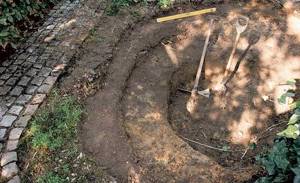
Types of waterproofing for an artificial pond:
- polyethylene film - an inexpensive material that is not resistant to ultraviolet radiation;
- LDPE – high-density polyethylene. Visually, it is practically no different from polyethylene, but has greater flexibility and durability.
- PVC - polyvinyl chloride - is a strong and durable material, the edges of which are welded together.
- rubber and butyl sheets are the most optimal, but expensive option. The service life of this material is practically unlimited.

Experts recommend avoiding plastic film for waterproofing. It copes with its function, but lasts no more than 2 years. If you want your pond to last longer, choose more durable materials.
Materials and tools:
- shovel;
- protective film or reservoir;
- pipes for supplying and draining water;
- valve;
- geotextile material or sand
It's better to see it once. The whole process of arranging a pond in pictures looks like this:
Construction of a decorative pond
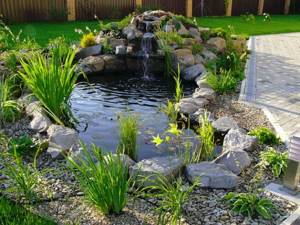
There is another way to arrange a pond - a concrete bowl, but this method is labor-intensive and expensive, so it is not currently used. Construction begins by marking the selected area and removing a layer of turf. After this, you can start digging a pit of the desired shape. In this case, be sure to leave the edges slightly inclined (flat, not steep). Next, if you plan to make a decorative pond using polyvinyl chloride film rather than a finished tank, you need to line the bottom of the future reservoir with waterproof material. Clay is quite suitable for these purposes. It must be laid in two layers - the second after the first has completely dried (a waterproof film must be laid between them). After this, you should fill the bottom with gravel.
Important: if you plan to plant a pond with plants, you should make special depressions at the bottom and fill them with fertile soil.
How to make a decorative pond so that the water in it is always clean and fresh?
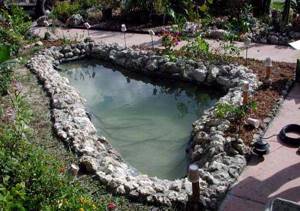
In order to ensure that the appearance of the reservoir located on your site always pleases with its appearance and gives freshness and coolness, it is necessary to ensure that the water in it is running. For these purposes, you need to lay two pipes: flow and waste. Through the flow pipe, water will flow into the reservoir, and through the waste pipe it will be discharged into the ditch. Please note: the level of the drainage ditch should be slightly lower than the level of the pond. For ease of use, you can install a valve on the drain pipe or simply close the hole with a plug as needed. The first option is the most practical.
Construction of a decorative pond using galoshes
You will need significantly less labor costs if you purchase a special tank for an artificial pond. People called these containers “galoshes.” Why is that? Everything is very simple: they are made of black plastic, and the shape of such tanks in its external outline resembles rubber shoes. But if you wish, you can always find and buy a bowl for a pond of the shape that suits you.

In order to set up a decorative pond at your dacha , you will need to purchase a special tank of a suitable size and shape: the cost of these is relatively low.
The main stages of arranging a reservoir:
- contour marking;
- digging pits;
- installation of container.
In order to correctly mark the contour of the reservoir, it is necessary to install the tank on the ground and vertically install slats along its perimeter at intervals of 40-50 cm, then tie them with twine. This way you will get the outline of the future pond.
Next, you can start digging a pit. During work, it is necessary to ensure that the bottom matches the topography of the container as accurately as possible, then the gaps will be minimal.
The container must be installed strictly horizontally. The tank should be filled with water gradually, while the gaps existing between it and the walls of the pit must be carefully filled with sand.
Note: if you want to equip a fountain in an artificial reservoir, it is important to purchase in advance a special pump and nozzles, which are installed during the installation of the reservoir.
The final stage is the design of the reservoir. In order for your man-made pond to look truly stylish and beautiful, for example, just like the fancy decorative ponds, photos of which we posted, you need to properly design its banks.
Decoration of the banks of an artificial reservoir
At this stage of work, you don’t have to limit the flight of your imagination. To decorate an artificial pond, you can use ceramic tiles, marble, granite, artificial stone, pebbles, wood, etc. These materials need to be used to camouflage the edges of the reservoir, which looks close to natural. It is important to fix them with cement mortar. If you plan to additionally equip your pond with a fountain, during the work you need to make sure that the pump hoses are hidden under tiles or stones.
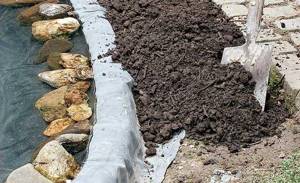
Next, you can sprinkle the bottom of the reservoir with pre-washed sand, lay small pebbles and plant aquatic plants in pots or baskets. You can plant decorative shrubs or just a flower bed around the pond.
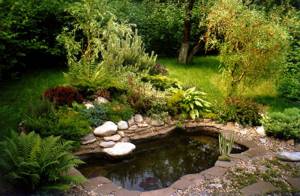
Decorative pond dwellers are always a joy. These can be aquarium fish and dwarf turtles. And if you run lights along the bottom of the pond or place floating flashlights on batteries on the surface, you can create a real extravaganza of light and water.
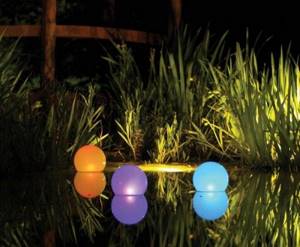
Pond care
- To keep an artificial pond in good condition, it will need maintenance.
- First of all, you need to get a bottom vacuum cleaner to collect debris.
- During leaf fall, you will need to cover the pond with a net to prevent leaves from falling into the water.
- If there are fish living in the pond, then they will need filtration and aeration of the water.
- To avoid greening of the water, it is either filtered and purified (for this the reservoir must be flowing), or planted with oxygen-producing plants: swampweed, hornwort, elodea.
- If you plant water lilies or egg capsules in a pond, their wide leaves will prevent the sun's rays and overheating of the water.
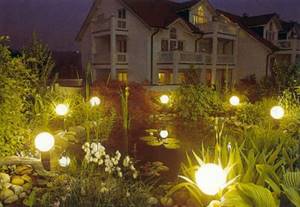
An artificial pond on your own plot is an important element of landscape design, the arrangement of which must be approached with sense, feeling, and arrangement! And then the beauty created by your hands will delight both you and your guests!
Finish options for stationary models
Finishing the pit of a stationary pool is carried out with various materials. For registration choose:
- PVC film;
- polypropylene;
- classic tiles;
- mosaic design.
PVC film is available in a wide color palette. To decorate a tank in a country house, the following shades are usually chosen:
- blue;
- turquoise;
- blue;
- white.
The material simultaneously combines two functions – waterproofing and decorative.
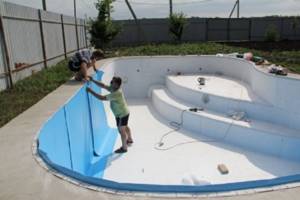
Polypropylene has excellent performance characteristics. Main advantages of the material:
- resistance to aggressive environments;
- high strength welding seams;
- durability.
As in the case of PVC film, when decorating a pool at the dacha, preference is given to blue-blue shades.
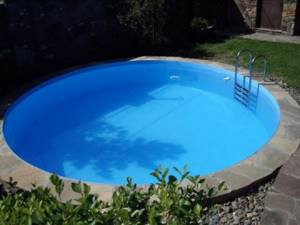
Attention! When choosing tiles or mosaics to decorate the surface of a stationary tank, preference is given to materials with low water absorption rates.
Finishing with ceramic tiles is usually carried out in public swimming pools; it is better to decorate containers for individual use with mosaics. Original overflows will provide a high degree of aesthetic design.

Selecting a location and determining dimensions
One of the key points of competent design of a swimming pool at a dacha is the choice of location, especially for stationary structures. The optimal conditions are the presence of clay soil. This is due to the ability of the soil to reduce water loss when the waterproofing layer is damaged.
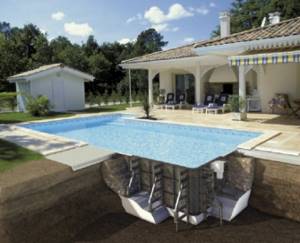
To ensure that the design and further maintenance of an artificial reservoir does not create unnecessary problems, it is worth considering a number of points:
- It is desirable that the area in the country house, which is allocated for the tank, have a natural slope. This will make it easier to design the drainage system at the dacha.
- The presence of trees near the pool is not recommended. Firstly, the shade from vegetation interferes with the process of warming up the water. Secondly, fallen leaves provoke excessive water pollution. Thirdly, the root system can damage the waterproofing design. The most aggressive representatives of the flora include poplar, chestnut and willow.
- After studying the wind rose, the pool at the dacha is positioned in such a way that the wind moves along the tank. This will allow debris to accumulate near one side and make it easier to clean.
- The presence of a water supply nearby will reduce construction costs and facilitate the process of filling the tank with water.
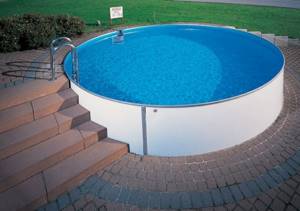
The shape of the pool at the dacha is selected depending on the purpose of the artificial reservoir. Serious swimming lessons require you to choose a rectangular design. It is better to organize children's fun in a round container. The extraordinary configuration of the bowl will help satisfy the desire to create an exquisite landscape design at the dacha.
The depth for adults varies between 1.5-2.3 meters. This will be enough for diving and ski jumping. Typically, the design of the maximum depth of the pool is carried out from one edge, where the tower is located. It is better to leave the entry point at a level of one and a half meters.
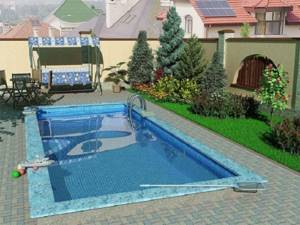
Pool options for home
The main types of modern pools for a country house are stationary, prefabricated and inflatable . The last option is the most budget-friendly and easiest to implement.
The inflatable pool can be placed anywhere. Its functionality is minimal, but you can remove such a pool from the site whenever you wish.

Advice: most often such pools are chosen for children's recreation, if there is no regular one on the site, or it is safe only for adults.
A folding pool has similar advantages. In terms of dimensions, it is significantly inferior to the stationary version, but it can accommodate more people than an inflatable one, and is more durable, as it is made from durable materials.
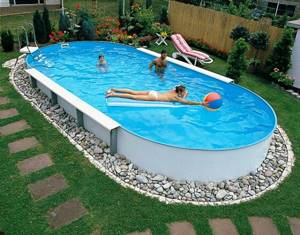
A stationary pool is the most common. And its main feature is that you are not limited in the choice of design : the design of the pool in the house can be adjusted to your preferences and tastes. In addition, such a pool is the most reliable and stable, can be large in size and accommodate an unlimited number of people.
In a standard pool, it is possible to use different functions: hydromassage, water heating, lighting. A slide or diving board can be connected to one side of the pool, located both on the site and in the house. But do not forget that this particular pool is the most expensive.
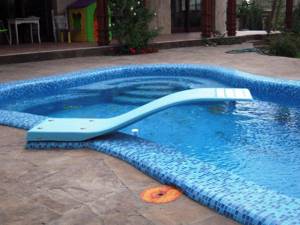
Modern swimming pools may also differ in their water filtration features . Depending on the shape of the pool, you can choose a skimmer or overflow method.
Skimmer-type filters are suitable for standard rectangular-shaped pools: they remove the top contaminated layer of water, returning purified water that has been disinfected to the pool through the walls.

Overflow pools are equipped with special holes in the side walls, through which water with contaminants flows out. Old water is displaced by supplying clean water from holes located at the bottom.
To ensure that the pool always functions as it should, take care to seal the surfaces. The presence of extra holes in the side walls or at the bottom is unacceptable: such a pool will have to be repaired or completely replaced with a new one, if this is not a stationary option.

